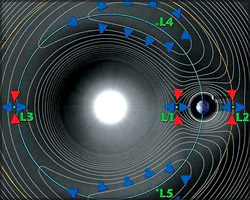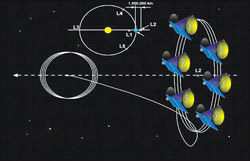 What
are Lagrange Points? What
are Lagrange Points?
As
you may have heard, outer space is a maze of mysteries. Astronomers,
scientists and many other parties have come up with various amazing
solutions to observe other worlds as well as our own Planet Earth from a
distance.
|

Joseph Louis Lagrange |
These objectives have been achieved through missions like the Hubble
Telescope, International Space Station, Chandra Observatory and so on.
However, have you ever given any thought to how space telescopes and
space stations are set up or stationed in outer space? Furthermore, have
you considered how significant the difference between parking a car on
the streets and parking such a space object in outer space is? In
astronomy, parking objects in space is really serious business.
Geo-stationary orbits or parking orbits have been found around the
Earth which lie on a particular height for a given mass of a space
object, and these can exist above a specific point above the Earth.
In this situation, the orbit of the particular object lies around the
Earth. But, think of the following fact as well. With enough speed, a
spacecraft can break loose from the Earth's gravity and enter an orbit
around the Sun, like that of a planet.
If it then orbits the Sun, taking the same period as the Earth, it
may keep a fixed position relative to Earth. Exploring along this line
has led to the discovery of what are called Lagrange Points.
***
What and where are the Lagrange Points?
Going directly by the definition, Lagrange Points are the 'five
positions in an orbital configuration (arrangement) where a small object
affected only by gravity can theoretically be stationary relative to two
larger' objects'.
 An
ideal example for this would be the scenario of having a satellite
stationary, with respect to the Earth and Moon. The Lagrange Points are
the positions where the combined gravitational pull of the two large
masses provides exactly the centripetal force required to rotate with
them. A centripetal force is the external force required to make a body
follow a circular path at constant speed. An
ideal example for this would be the scenario of having a satellite
stationary, with respect to the Earth and Moon. The Lagrange Points are
the positions where the combined gravitational pull of the two large
masses provides exactly the centripetal force required to rotate with
them. A centripetal force is the external force required to make a body
follow a circular path at constant speed.
Lagrange Points are quite similar to geosynchronous orbits, but they
allow an object to be in a 'fixed' position in space rather than an
orbit in which its relative position changes continuously.
At this point you must understand that Lagrange Points exist for any
two large objects and not just for Earth and Sun. These five points are
named L1 through to L5 and are named after the Italian-French
mathematician who pointed them out, Joseph Louis Lagrange.
Let's consider the system made up by the Earth and Sun and their
Lagrange Points. Although we speak of the five points collectively, the
importance and stability of these five points vary.
 When
the stabilities are concerned, three points are unstable and two are
stable. The unstable Lagrange points L1, L2 and L3 lie along the line
connecting the two large masses which are the Earth and Sun. L1 resides
between the two large masses, and L2 resides beyond the smaller mass,
which is the Earth. When
the stabilities are concerned, three points are unstable and two are
stable. The unstable Lagrange points L1, L2 and L3 lie along the line
connecting the two large masses which are the Earth and Sun. L1 resides
between the two large masses, and L2 resides beyond the smaller mass,
which is the Earth.
L3 resides beyond the larger mass. The stable Lagrange Points L4 and
L5 form the apex (top) of two equilateral triangles that have the large
masses at their vertices. L1 lies about four times the distance to the
Moon or 1/100 the distance to the Sun from Earth.
***
How are these points useful?
Where the importance of the five points are concerned, L1 and L2 are
found to be quite useful. L1 has an uninterrupted view of the Sun, and
is a very good position for monitoring the solar wind, which reaches it
about one hour before reaching Earth.
 Therefore
it is currently home to the Solar and Heliospheric Observatory Satellite
(SOHO). The L2 point of the Earth-Sun system became home to the MAP
Satellite and will be for the James Webb Space Telescope which we
mentioned in a previous edition of the Space Station. Therefore
it is currently home to the Solar and Heliospheric Observatory Satellite
(SOHO). The L2 point of the Earth-Sun system became home to the MAP
Satellite and will be for the James Webb Space Telescope which we
mentioned in a previous edition of the Space Station.
Astronomers have not found L3 significantly useful so far, since it
remains hidden behind the Sun at all times. However, some interesting
talk has been brewing up regarding the existence of another planet,
'Planet X' in this point, which has not yet been proven.
The stable L4 and L5 points of the Earth - Moon system have been
studied as possible sites for artificial space colonies in some distant
future which can probably be 'very' distant.
Although the two points L1 and L2 have been found useful, they are
considered unstable. They are unstable on a time scale of approximately
23 days, which requires satellites parked at these positions to perform
regular course and attitude corrections using their onboard rocket
engines and sometimes using the gravitational pull from the Moon. When
L4 and L5 points are considered in a general sense, it has been found
that they can have stable orbits only if the mass ratio between the two
large masses exceeds 24.96. In such a situation, the objects orbiting in
these points are called 'Trojans'.
The mass ratio condition given above is true for the Earth-Sun system
as well as the Earth Moon system, and many other pairs of bodies in
outer space. The Sun-Jupiter system has many asteroids in these points
although Earth-Moon and Earth-Sun systems do not.
However, L4 and L5 points of the Earth-Sun system contain
interplanetary dust, and such points of the Earth-Moon system also
contain interplanetary dust in what are called 'Kordylewski clouds'.
Compiled by Aravinda Dassanayake |
